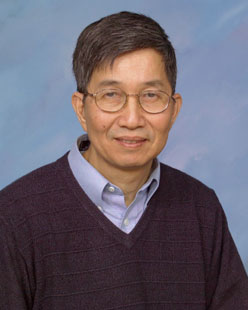Dr. Ching W. Tang appointed the Doris Johns Cherry Professor of Chemical Engineering
August 4, 2006

(August 2006) The Department of Chemical Engineering is proud to announce the tenured appointment of Dr. Ching W. Tang as the Doris Johns Cherry Professor of Chemical Engineering effective July 1, 2006.
MEDIA CONTACT: Jonathan Sherwood (585) 273-4726
January 19, 2007
Inventor of Next-Generation Display Technology Joins Faculty
Professor Ching W. Tang
OLED Creator Ching W. Tang Named Doris Johns Cherry Professor
Ching W. Tang, professor of chemical engineering and chemistry, and father of the multi-billion-dollar organic light-emitting diode (OLED) industry, has been named the Doris Johns Cherry Professor at the University of Rochester. Tang, the world leader in organic electronics including OLEDs and solar cells, is the first to hold the new chair.
"We are very pleased to have successfully recruited Ching Tang and welcome his timely arrival in the Department of Chemical Engineering," says Shaw Chen, chair of the department. "Our commitment to new alternative energy sources and flat-panel displays will be greatly enhanced by Ching's leadership in these fields. Other programs across engineering and the sciences will also be well served by the interdisciplinary nature of his research." Tang is known internationally for his pioneering work on organic solar cells and OLEDs, which is the new flat-panel display that offers superior imagery for far less power than even the most advanced LCD displays today.
In addition to the discovery of efficient OLEDs, Tang has been credited with a number of key innovations leading to the commercialization of a new flat-panel display technology, including the development of robust luminescent materials, novel color pixilation methods, fabrication processes for the manufacture of OLED displays, and the adaptation of technology for high-definition OLED displays.
Tang is also widely recognized for his seminal work early in photovoltaics, which could lead to major improvements in the ability of solar cells to capture energy from the sun. OLED and photovoltaics are like two sides of the same coin; one converts energy into light for a display, and the other converts light from the sun into energy.
"Ching Tang is the most accomplished and the highest regarded innovator in the organic electronics industry, and we're delighted to have him as a member of our engineering program," says Kevin J. Parker, dean of the School of Engineering and Applied Sciences at the University of Rochester. "Our Department of Chemical Engineering has grown dramatically over the last few years, sporting a superb forward-looking doctoral program. Ching's addition highlights the hallmarks of the University's engineering, from the photonics started by the nation's first optical doctoral program to our strategic focus on alternative energies at present."
Tang is a fellow of the American Physical Society, of the Society for Information Display, and was recently elected a member of the National Academy of Engineering. He holds more than 70 U.S. patents and has published 70 papers, including three highly cited papers based on his original work on solar cells and OLEDs. Tang has received a number of awards, including the Eastman Innovation Award (2000) from Eastman Kodak Company, the Carothers Award (2001) and the Team Innovation Award (2003) from the American Chemical Society, the Jan Rajchman Prize (2001) from the Society for Information Display, the Humboldt Research Award (2005), and the Daniel E. Noble Award (2007) from the Institute of Electrical and Electronics Engineers.
Tang obtained a bachelor's degree in chemistry from the University of British Columbia in 1970, and a doctorate from Cornell University in 1975, also in chemistry. Tang joined the Kodak Research Laboratories after graduating from Cornell in 1975. Initially, he worked on solar energy conversion and succeeded in developing the first organic solar cells with 1 percent efficiency based on a structure that he invented. A few years later, he went on to discover the high-efficiency organic light emitting diode—the OLED, and spent the rest of his career at Kodak primarily leading the research and development effort in OLED.
The Doris Johns Cherry Professorship was established in July 2006, with a gift of $1.5 million. Doris Johns Cherry died on Jan. 17, 2005, and bequeathed a generous portion of her estate for unrestricted support of the University.
"Though I did not know Doris, I have learned that she made major decisions only after completing her due diligence," says Joel Seligman, president of the University. "The fact that she chose to leave the bulk of her estate to the University and gave us the flexibility to designate it to endow this important, named professorship is a high compliment. I believe that today's celebration affirms the wisdom of her choice. We will forever be grateful to Doris, and to her friend and counselor Jim Vazzana for the role he played in so carefully fulfilling her wishes."
Mrs. Cherry graduated from West High School in Rochester at 16, earned a bachelor's in economics from the University of Rochester in 1943, and was a member of Theta Eta Sorority. After returning to Rochester in the 1950s from Chicago, she worked at the University in the benefits office for eight year before joining the Wiedman & Wiedman law firm where she worked until the mid-90s. She served as communication chair for her 50th reunion in 1993.
In recognition of Mrs. Cherry's generosity, a tree was dedicated in her name just outside Wilson Commons on the River Campus of the University.
